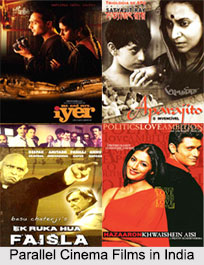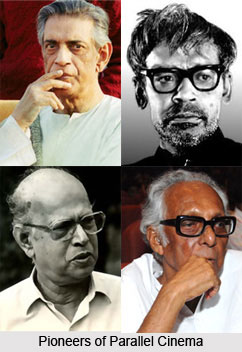 Parallel Cinema is a film movement in Indian Cinema, which originated in the state of West Bengal in the 1950s as an alternative to the mainstream commercial Indian cinema, represented especially by the popular Hindi cinema known as Bollywood. Such films, unlike the commercial flicks which follow the concept of conventional entertainment facets, are purely artistic cinematic pieces that mostly showcase reality and reality-oriented themes and stories that pertain to the prevalent social, political and cultural scenarios. Parallel Cinema in India is inspired by Italian Neo-realism, beginning just before the French New Wave and the Japanese New Wave, and was a precursor to the Indian New Wave of the 1960s.
Parallel Cinema is a film movement in Indian Cinema, which originated in the state of West Bengal in the 1950s as an alternative to the mainstream commercial Indian cinema, represented especially by the popular Hindi cinema known as Bollywood. Such films, unlike the commercial flicks which follow the concept of conventional entertainment facets, are purely artistic cinematic pieces that mostly showcase reality and reality-oriented themes and stories that pertain to the prevalent social, political and cultural scenarios. Parallel Cinema in India is inspired by Italian Neo-realism, beginning just before the French New Wave and the Japanese New Wave, and was a precursor to the Indian New Wave of the 1960s.Origin of Parallel Cinema in India
Parallel Cinema in India traces its origin back to the 1950s in the Bengali Cinema. It developed with the aim of developing an alternative to mainstream commercial films of India. It served as a precursor to the Indian New Wave which followed in the next decade. The movement of parallel cinema began in Bengali films with the initiatives of eminent filmmakers like Satyajit Ray, Tapan Sinha, Ritwik Ghatak, Mrinal Sen and others. Gradually, the concept got highlighted in other film industries as well. The prominent features that delineate parallel cinema from the commercial ones include serious and realistic content, illumination of socio-political scenario, naturalism and exclusion of typical entertaining elements of a commercial film.
The era of the 50s when parallel cinema gained prominence is often regarded as the Golden Age of Indian Cinema. Indian Literature formed a vital inspiration for such films and thus they became the reflections of contemporary Indian society. Indian film industry has had, right from the beginning, members who have made efforts to use cinema as more than a medium for entertainment. Existing issues became the burning topics of parallel cinema often accompanied by the new thought provoking ideas. Although a few realistic films emerged in early phases of Indian cinema, Chetan Anand's ‘Neecha Nagar’ (1946) being an excellent example, the movement gained momentum a little later when a few filmmakers wanted to break the monotony of film genres made only for entertainment. Satyajit Ray, through his first film ‘Pather Panchali’ in 1955, was accredited as the pioneer of parallel cinema in India. His film attained a distinct stature in the film arena and became one of the greatest films of all time. The film was followed by ‘Aparajito’ (1956) and ‘Apur Sansar’ (1959), together forming The Apu Trilogy and winning several accolades and acclamations at major international film festivals. Other Bengali films that conferred momentum to parallel cinema include ‘Ajantrik’, ‘Abhijan’, ‘Bhuvan Shome’ and others.

Parallel Cinema in Bollywood
Bollywood, an industry known for its surrealism or “fantastical” movies, had a few notable films during the Golden Age that were art films but also garnered commercial success, made with a successful blend of art and commercial facets. An early example of this is Bimal Roy's ‘Do Bigha Zamin’ (1953), which was both a critical and commercial success. It won the International Prize at the 1954 Cannes Film Festival and paved the way for the Indian New Wave. Hrishikesh Mukherjee, one of Hindi cinema's most successful filmmakers, was named the pioneer of “middle cinema” and was known for making films that reflected the changing middle-class ethos. Filmmaker Basu Chatterjee too built his plots on middle-class lives in films like ‘Piya Ka Ghar’, ‘Rajnigandha’ and ‘Ek Ruka Hua Faisla’. Another filmmaker whose integrated art and commercial cinema was Guru Dutt, whose film ‘Pyaasa’ (1957) featured in Time magazine's "All-TIME" 100 best movies list, and is considered a landmark cult in Hindi Cinema.
The Government of India started financing such independent art films based on Indian themes in the 1960s, to popularize and render significance to this genre. Parallel cinema witnessed a wider reach and grew in Bollywood in 1970s and 1980s with the efforts of directors like Gulzar, Saeed Akhtar Mirza, Shyam Benegal, Rajinder Singh Bedi and Mani Kaul who were later joined by Govind Nihalani and Mahesh Bhatt. Their creations attained huge praises by critics on national as well as international arena with films such as ‘Uski Roti’ (1971), ‘Ashadh Ka Ek Din’ (1972), ‘Duvidha’ (1974) and ‘Ek Ruka Hua Faisla’ (1986). Kumar Shahani who was a student of Ritwik Ghatak made ‘Maya Darpan’ (1972), which marked itself as a landmark film of Indian art cinema. Parallel cinema in India also conferred prominence to the career of new genre of actors of immense artistic calibre and finesse, the likes of Smita Patil, Shabana Azmi, Naseeruddin Shah, Pankaj Kapoor, Om Puri and many others. The actors of commercial cinema also ventured into this genre and got a platform to showcase their skills through unconventional portrayals.
Parallel Cinema in South India
Parallel Cinema entered the realm of the prominent South Indian film industries of Indian Cinema at a much later stage. Adoor Gopalakrishnan, who is often known as the spiritual heir of Satyajit Ray, brought this genre to Malayalam cinema in 1972 with his movie ‘Swayamvaram’. The period from 1980s to early 1990s marks the golden age of the Malayalam film industry. Other filmmakers who joined in the movement included Shaji N. Karun, T. V. Chandran, Bharathan and others. Some of the significant examples of parallel cinema in Malayalam films enlist ‘Elippathayam’ (1981), ‘Mathilukal’ (1989), ‘Vanaprastham’ (1999) etc. which were recognised with accolades at various prestigious film festivals.
For more, visit the link below: